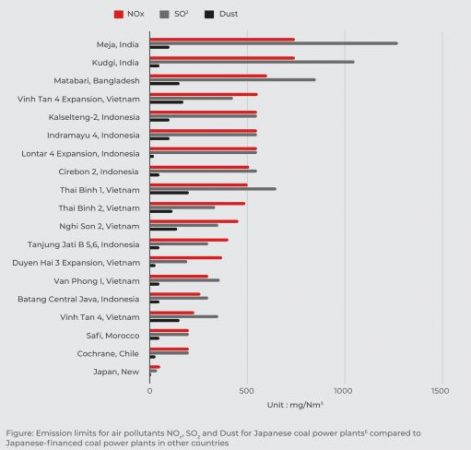China & Japan Under Spotlight for ‘Double Standards’ Over Coal Power Generation
 Both China and Japan have been covertly supporting coal industry in other countries
Both China and Japan have been covertly supporting coal industry in other countries
Coal is the single worst contributor to global climate change, responsible for almost half the world’s carbon dioxide emissions. Yet Eastern countries’ obsession with coal power never seems to dim despite the increasingly acknowledged need to cut back. Even as advanced economies continue to shut coal plants, as well as their institutions pause fresh funding to coal projects worldwide.
China
The eastern hemisphere’s largest economy China has built a deserved reputation for doing everything as the ‘largest’ in this world. Its plan called the Belt and Road initiative is no less in its scale and ambition. Since 2017, China has assured the world that its Belt and Road initiative (BRI), under which it seeks to connect economies with top-quality infrastructure that would have green projects.
Chinese president Xi Jinping touted BRI as a “vision of green development and a way of life and work that is green, low-carbon, circular and sustainable.”
Despite this, its carbon emissions jumped in 2018, the first time since 2014. All because nearly 40 percent of the Chinese Development Bank (CDB) and Chinese Ex-Im spending on electricity generation has gone toward coal.
Between 2013 and 2018, by conservative estimates, fresh coal generated power will contribute to annual emissions equivalent to that of the Netherlands. These banks have fuelled more coal power than clean energy by comparison.
China has long been the world’s largest exporter of coal-power equipment, exporting twice as much as its nearest competitor. At the same time, Chinese companies are reportedly building an estimated 140 coal plants abroad, including in countries like Egypt and Pakistan that previously burned little to no coal.
Most of the Chinese-financed coal-fired power plants built overseas use low-efficiency, subcritical coal technology, which produces some of the highest emissions of any form of power generation. This means that out of 38 countries where these plants are set up, one third recorded jump in emissions. Chinese foreign aid since 2013 is making the countries’ power generation industry emit more.
The worst-hit has been Pakistan, where investments in Coal power have jumped more than twice as has the emissions compared to 2012.
The damage doesn’t stop there. China has been funneling investments into non-fossil projects that are not solar or wind but hydroelectric dams that could devastate millions of farmers and fishermen. Beijing is seen as leveraging these potentially environmentally and socially harmful infrastructure projects for diplomatic capital.
Contrarily, inside China, it plans to rely less on coal-fired generation for its planned electricity capacity additions than those added in the past decade, according to Princeton University.
Japan
Another eastern power Japan has been found with dirty coal dust in its hand. The Netherlands based environment group Greenpeace in its report made some shocking revelations about Japan funding toxic coal plants abroad emitting more pollution than domestic plants.
Much like China, the report released last week took names and said that Japanese Government and its public finance agencies JBIC, JICA, NEXI are exporting pollution to other countries by funding coal-fired power that emits far more toxic air pollutants than would be allowed in Japan.
This deadly double standard in emission limits allows Japanese-financed coal power plants to emit up to 13 times more nitrogen oxides (NOx), 33 times more sulfur dioxide (SO2) and 40 times more dust than those plants built in Japan.

The report reveals that the public finance agencies’ 16.7 billion USD investment in coal plants between January 2013 and May 2019 is estimated to cause a total of 148,000 to 410,000 avoidable premature deaths over the typical 30 year operation period of such plants.
“It’s unfortunate to see the gap between Japan’s promises of exporting quality infrastructure and the reality of low-quality coal technology exports. Japan should honor its trading partners and citizens of those countries by promoting energy technologies that stop hurting people’s health and the environment,” said Senior Energy Campaigner, Hanna Hakko at Greenpeace Japan.
“Japan could become a champion for renewables, but that requires giving up the harmful export of polluting coal technology.”
Japan is currently the only G7 country still actively building new coal power plants at home and abroad and is the second-largest public investor in overseas coal projects among the G20 countries.
Approx. 3.3 million people would be exposed to dangerous sulfur dioxide (SO2) levels from the emissions of the power plants, when operated to local emission limits.
The most premature deaths due to Japanese investments are projected to occur in India (160,000) and Indonesia (72,000), followed by Vietnam (36,000) and Bangladesh (14,000) over the 30 years of coal power plant operations due to long-term exposure to fine particulate matter (PM2.5) and nitrogen dioxide (NO2) pollution.
Both the countries despite their differing stance on the international forums have been endorsing coal power generation in their own boundaries or elsewhere. This double standard has now become quite dangerous as the world accidents like the Amazon Fires, the Arctic and other regions losing glaciers at an unprecedented rate, heatwaves in Europe while countries with coasts facing flash floods and cloud bursts, all point to the last lap in Climate Change and we are fast running out of time to get our acts together.




